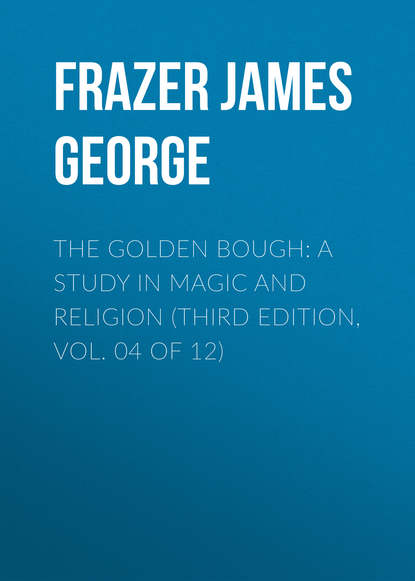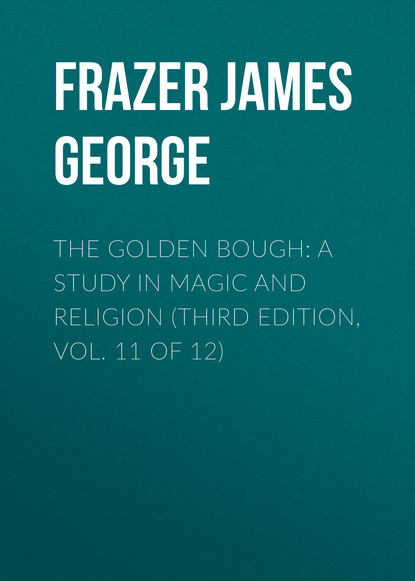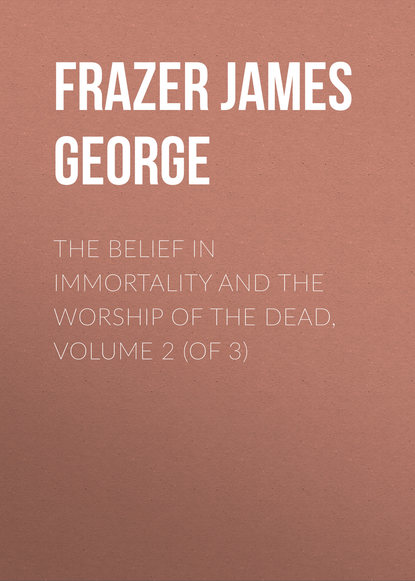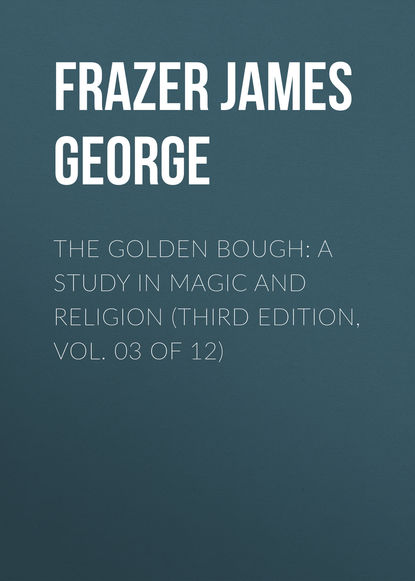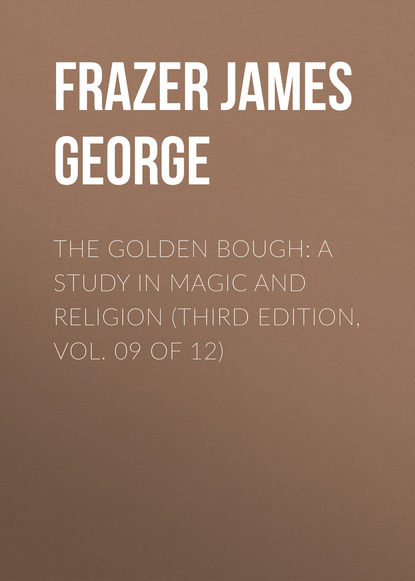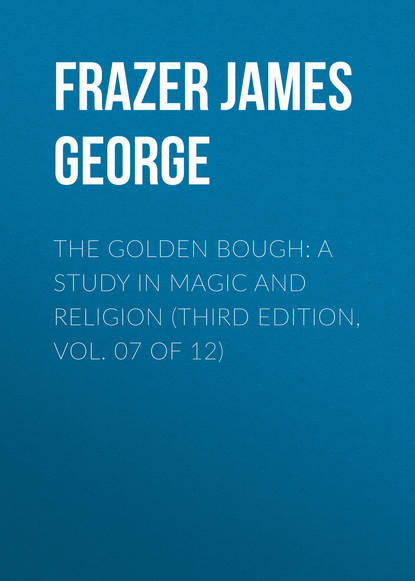
Полная версия
The Golden Bough: A Study in Magic and Religion (Third Edition, Vol. 07 of 12)

James George Frazer
The Golden Bough: A Study in Magic and Religion (Third Edition, Vol. 07 of 12)
Preface
In the last part of this work we examined the figure of the Dying and Reviving God as it appears in the Oriental religions of classical antiquity. With the present instalment of The Golden Bough we pursue the same theme in other religions and among other races. Passing from the East to Europe we begin with the religion of ancient Greece, which embodies the now familiar conception in two typical examples, the vine-god Dionysus and the corn-goddess Persephone, with her mother and duplicate Demeter. Both of these Greek divinities are personifications of cultivated plants, and a consideration of them naturally leads us on to investigate similar personifications elsewhere. Now of all the plants which men have artificially reared for the sake of food the cereals are on the whole the most important; therefore it is natural that the religion of primitive agricultural communities should be deeply coloured by the principal occupation of their lives, the care of the corn. Hence the frequency with which the figures of the Corn-mother and Corn-maiden, answering to the Demeter and Persephone of ancient Greece, meet us in other parts of the world, and not least of all on the harvest-fields of modern Europe. But edible roots as well as cereals have been cultivated by many races, especially in the tropical regions, as a subsidiary or even as a principal means of subsistence; and accordingly they too enter largely into the religious ideas of the peoples who live by them. Yet in the case of the roots, such as yams, taro, and potatoes, the conception of the Dying and Reviving God appears to figure less prominently than in the case of the cereals, perhaps for the simple reason that while the growth and decay of the one sort of fruit go on above ground for all to see, the similar processes of the other are hidden under ground and therefore strike the popular imagination less forcibly.
Having surveyed the variations of our main theme among the agricultural races of mankind, we prosecute the enquiry among savages who remain more or less completely in the hunting, fishing, and pastoral stages of society. The same motive which leads the primitive husbandman to adore the corn or the roots, induces the primitive hunter, fowler, fisher, or herdsman to adore the beasts, birds, or fishes which furnish him with the means of subsistence. To him the conception of the death of these worshipful beings is naturally presented with singular force and distinctness; since it is no figurative or allegorical death, no poetical embroidery thrown over the skeleton, but the real death, the naked skeleton, that constantly thrusts itself importunately on his attention. And strange as it may seem to us civilised men, the notion of the immortality and even of the resurrection of the lower animals appears to be almost as familiar to the savage and to be accepted by him with nearly as unwavering a faith as the obvious fact of their death and destruction. For the most part he assumes as a matter of course that the souls of dead animals survive their decease; hence much of the thought of the savage hunter is devoted to the problem of how he can best appease the naturally incensed ghosts of his victims so as to prevent them from doing him a mischief. This refusal of the savage to recognise in death a final cessation of the vital process, this unquestioning faith in the unbroken continuity of all life, is a fact that has not yet received the attention which it seems to merit from enquirers into the constitution of the human mind as well as into the history of religion. In the following pages I have collected examples of this curious faith; I must leave it to others to appraise them.
Thus on the whole we are concerned in these volumes with the reverence or worship paid by men to the natural resources from which they draw their nutriment, both vegetable and animal. That they should invest these resources with an atmosphere of wonder and awe, often indeed with a halo of divinity, is no matter for surprise. The circle of human knowledge, illuminated by the pale cold light of reason, is so infinitesimally small, the dark regions of human ignorance which lie beyond that luminous ring are so immeasurably vast, that imagination is fain to step up to the border line and send the warm, richly coloured beams of her fairy lantern streaming out into the darkness; and so, peering into the gloom, she is apt to mistake the shadowy reflections of her own figure for real beings moving in the abyss. In short, few men are sensible of the sharp line that divides the known from the unknown; to most men it is a hazy borderland where perception and conception melt indissolubly into one. Hence to the savage the ghosts of dead animals and men, with which his imagination peoples the void, are hardly less real than the solid shapes which the living animals and men present to his senses; and his thoughts and activities are nearly as much absorbed by the one as by the other. Of him it may be said with perhaps even greater truth than of his civilised brother, “What shadows we are, and what shadows we pursue!”
But having said so much in this book of the misty glory which the human imagination sheds round the hard material realities of the food supply, I am unwilling to leave my readers under the impression, natural but erroneous, that man has created most of his gods out of his belly. That is not so, at least that is not my reading of the history of religion. Among the visible, tangible, perceptible elements by which he is surrounded – and it is only of these that I presume to speak – there are others than the merely nutritious which have exerted a powerful influence in touching his imagination and stimulating his energies, and so have contributed to build up the complex fabric of religion. To the preservation of the species the reproductive faculties are no less essential than the nutritive; and with them we enter on a very different sphere of thought and feeling, to wit, the relation of the sexes to each other, with all the depths of tenderness and all the intricate problems which that mysterious relation involves. The study of the various forms, some gross and palpable, some subtle and elusive, in which the sexual instinct has moulded the religious consciousness of our race, is one of the most interesting, as it is one of the most difficult and delicate tasks, which await the future historian of religion.
But the influence which the sexes exert on each other, intimate and profound as it has been and must always be, is far indeed from exhausting the forces of attraction by which mankind are bound together in society. The need of mutual protection, the economic advantages of co-operation, the contagion of example, the communication of knowledge, the great ideas that radiate from great minds, like shafts of light from high towers, – these and many other things combine to draw men into communities, to drill them into regiments, and to set them marching on the road of progress with a concentrated force to which the loose skirmishers of mere anarchy and individualism can never hope to oppose a permanent resistance. Hence when we consider how intimately humanity depends on society for many of the boons which it prizes most highly, we shall probably admit that of all the forces open to our observation which have shaped human destiny the influence of man on man is by far the greatest. If that is so, it seems to follow that among the beings, real or imaginary, which the religious imagination has clothed with the attributes of divinity, human spirits are likely to play a more important part than the spirits of plants, animals, or inanimate objects. I believe that a careful examination of the evidence, which has still to be undertaken, will confirm this conclusion; and that if we could strictly interrogate the phantoms which the human mind has conjured up out of the depths of its bottomless ignorance and enshrined as deities in the dim light of temples, we should find that the majority of them have been nothing but the ghosts of dead men. However, to say this is necessarily to anticipate the result of future research; and if in saying it I have ventured to make a prediction, which like all predictions is liable to be falsified by the event, I have done so only from a fear lest, without some such warning, the numerous facts recorded in these volumes might lend themselves to an exaggerated estimate of their own importance and hence to a misinterpretation and distortion of history.
J. G. Frazer.
Cambridge, 4th May 1912.
Chapter I. Dionysus
Death and resurrection of Oriental gods of vegetation. The Dying and Reviving god of vegetation in ancient Greece.
In the preceding part of this work we saw that in antiquity the civilised nations of western Asia and Egypt pictured to themselves the changes of the seasons, and particularly the annual growth and decay of vegetation, as episodes in the life of gods, whose mournful death and happy resurrection they celebrated with dramatic rites of alternate lamentation and rejoicing. But if the celebration was in form dramatic, it was in substance magical; that is to say, it was intended, on the principles of sympathetic magic, to ensure the vernal regeneration of plants and the multiplication of animals, which had seemed to be menaced by the inroads of winter. In the ancient world, however, such ideas and such rites were by no means confined to the Oriental peoples of Babylon and Syria, of Phrygia and Egypt; they were not a product peculiar to the religious mysticism of the dreamy East, but were shared by the races of livelier fancy and more mercurial temperament who inhabited the shores and islands of the Aegean. We need not, with some enquirers in ancient and modern times, suppose that these Western peoples borrowed from the older civilisation of the Orient the conception of the Dying and Reviving God, together with the solemn ritual, in which that conception was dramatically set forth before the eyes of the worshippers. More probably the resemblance which may be traced in this respect between the religions of the East and the West is no more than what we commonly, though incorrectly, call a fortuitous coincidence, the effect of similar causes acting alike on the similar constitution of the human mind in different countries and under different skies. The Greek had no need to journey into far countries to learn the vicissitudes of the seasons, to mark the fleeting beauty of the damask rose, the transient glory of the golden corn, the passing splendour of the purple grapes. Year by year in his own beautiful land he beheld, with natural regret, the bright pomp of summer fading into the gloom and stagnation of winter, and year by year he hailed with natural delight the outburst of fresh life in spring. Accustomed to personify the forces of nature, to tinge her cold abstractions with the warm hues of imagination, to clothe her naked realities with the gorgeous drapery of a mythic fancy, he fashioned for himself a train of gods and goddesses, of spirits and elves, out of the shifting panorama of the seasons, and followed the annual fluctuations of their fortunes with alternate emotions of cheerfulness and dejection, of gladness and sorrow, which found their natural expression in alternate rites of rejoicing and lamentation, of revelry and mourning. A consideration of some of the Greek divinities who thus died and rose again from the dead may furnish us with a series of companion pictures to set side by side with the sad figures of Adonis, Attis, and Osiris. We begin with Dionysus.
Dionysus, the god of the vine, originally a Thracian deity.
The god Dionysus or Bacchus is best known to us as a personification of the vine and of the exhilaration produced by the juice of the grape.1 His ecstatic worship, characterised by wild dances, thrilling music, and tipsy excess, appears to have originated among the rude tribes of Thrace, who were notoriously addicted to drunkenness.2 Its mystic doctrines and extravagant rites were essentially foreign to the clear intelligence and sober temperament of the Greek race. Yet appealing as it did to that love of mystery and that proneness to revert to savagery which seem to be innate in most men, the religion spread like wildfire through Greece until the god whom Homer hardly deigned to notice had become the most popular figure of the pantheon. The resemblance which his story and his ceremonies present to those of Osiris have led some enquirers both in ancient and modern times to hold that Dionysus was merely a disguised Osiris, imported directly from Egypt into Greece.3 But the great preponderance of evidence points to his Thracian origin, and the similarity of the two worships is sufficiently explained by the similarity of the ideas and customs on which they were founded.
Dionysus a god of trees, especially of fruit-trees.
While the vine with its clusters was the most characteristic manifestation of Dionysus, he was also a god of trees in general. Thus we are told that almost all the Greeks sacrificed to “Dionysus of the tree.”4 In Boeotia one of his titles was “Dionysus in the tree.”5 His image was often merely an upright post, without arms, but draped in a mantle, with a bearded mask to represent the head, and with leafy boughs projecting from the head or body to shew the nature of the deity.6 On a vase his rude effigy is depicted appearing out of a low tree or bush.7 At Magnesia on the Maeander an image of Dionysus is said to have been found in a plane-tree, which had been broken by the wind.8 He was the patron of cultivated trees;9 prayers were offered to him that he would make the trees grow;10 and he was especially honoured by husbandmen, chiefly fruit-growers, who set up an image of him, in the shape of a natural tree-stump, in their orchards.11 He was said to have discovered all tree-fruits, amongst which apples and figs are particularly mentioned;12 and he was referred to as “well-fruited,” “he of the green fruit,” and “making the fruit to grow.”13 One of his titles was “teeming” or “bursting” (as of sap or blossoms);14 and there was a Flowery Dionysus in Attica and at Patrae in Achaia.15 The Athenians sacrificed to him for the prosperity of the fruits of the land.16 Amongst the trees particularly sacred to him, in addition to the vine, was the pine-tree.17 The Delphic oracle commanded the Corinthians to worship a particular pine-tree “equally with the god,” so they made two images of Dionysus out of it, with red faces and gilt bodies.18 In art a wand, tipped with a pine-cone, is commonly carried by the god or his worshippers.19 Again, the ivy and the fig-tree were especially associated with him. In the Attic township of Acharnae there was a Dionysus Ivy;20 at Lacedaemon there was a Fig Dionysus; and in Naxos, where figs were called meilicha, there was a Dionysus Meilichios, the face of whose image was made of fig-wood.21
Dionysus as a god of agriculture and the corn. The winnowing-fan as an emblem of Dionysus.
Further, there are indications, few but significant, that Dionysus was conceived as a deity of agriculture and the corn. He is spoken of as himself doing the work of a husbandman:22 he is reported to have been the first to yoke oxen to the plough, which before had been dragged by hand alone; and some people found in this tradition the clue to the bovine shape in which, as we shall see, the god was often supposed to present himself to his worshippers. Thus guiding the ploughshare and scattering the seed as he went, Dionysus is said to have eased the labour of the husbandman.23 Further, we are told that in the land of the Bisaltae, a Thracian tribe, there was a great and fair sanctuary of Dionysus, where at his festival a bright light shone forth at night as a token of an abundant harvest vouchsafed by the deity; but if the crops were to fail that year, the mystic light was not seen, darkness brooded over the sanctuary as at other times.24 Moreover, among the emblems of Dionysus was the winnowing-fan, that is the large open shovel-shaped basket, which down to modern times has been used by farmers to separate the grain from the chaff by tossing the corn in the air. This simple agricultural instrument figured in the mystic rites of Dionysus; indeed the god is traditionally said to have been placed at birth in a winnowing-fan as in a cradle: in art he is represented as an infant so cradled; and from these traditions and representations he derived the epithet of Liknites, that is, “He of the Winnowing-fan.”25
Use of the winnowing-fan to cradle infants. The winnowing-fan sometimes intended to avert evil spirits from children.
At first sight this symbolism might be explained very simply and naturally by supposing that the divine infant cradled in the winnowing-fan was identified with the corn which it is the function of the instrument to winnow and sift. Yet against this identification it may be urged with reason that the use of a winnowing-fan as a cradle was not peculiar to Dionysus; it was a regular practice with the ancient Greeks to place their infants in winnowing-fans as an omen of wealth and fertility for the future life of the children.26 Customs of the same sort have been observed, apparently for similar reasons, by other peoples in other lands. For example, in Java it is or used to be customary to place every child at birth in a bamboo basket like the sieve or winnowing-basket which Javanese farmers use for separating the rice from the chaff.27 It is the midwife who places the child in the basket, and as she does so she suddenly knocks with the palms of both hands on the basket in order that the child may not be timid and fearful. Then she addresses the child thus: “Cry not, for Njaï-among and Kaki-among” (two spirits) “are watching over you.” Next she addresses these two spirits, saying, “Bring not your grandchild to the road, lest he be trampled by a horse; bring him not to the bank of the river, lest he fall into the river.” The object of the ceremony is said to be that these two spirits should always and everywhere guard the child.28 On the first anniversary of a child's birthday the Chinese of Foo-Chow set the little one in a large bamboo sieve, such as farmers employ in winnowing grain, and in the sieve they place along with the child a variety of articles, such as fruits, gold or silver ornaments, a set of money-scales, books, a pencil, pen, ink, paper, and so on, and they draw omens of the child's future career from the object which it first handles and plays with. Thus, if the infant first grasps the money-scale, he will be wealthy; if he seizes on a book, he will be learned, and so forth.29 In the Bilaspore district of India it is customary for well-to-do people to place a newborn infant in a winnowing-fan filled with rice and afterwards to give the grain to the nurse in attendance.30 In Upper Egypt a newly-born babe is immediately laid upon a corn-sieve and corn is scattered around it; moreover, on the seventh day after birth the infant is carried on a sieve through the whole house, while the midwife scatters wheat, barley, pease and salt. The intention of these ceremonies is said to be to avert evil spirits from the child,31 and a like motive is assigned by other peoples for the practice of placing newborn infants in a winnowing-basket or corn-sieve. For example, in the Punjaub, when several children of a family have died in succession, a new baby will sometimes be put at birth into an old winnowing-basket (chhaj) along with the sweepings of the house, and so dragged out into the yard; such a child may, like Dionysus, in after life be known by the name of Winnowing-basket (Chhajju) or Dragged (Ghasitâ).32 The object of treating the child in this way seems to be to save its life by deceiving the spirits, who are supposed to have carried off its elder brothers and sisters; these malevolent beings are on the look-out for the new baby, but they will never think of raking for it in the dust-bin, that being the last place where they would expect to find the hope of the family. The same may perhaps be the intention of a ceremony observed by the Gaolis of the Deccan. As soon as a child is born, it is bathed and then placed on a sieve for a few minutes. On the fifth day the sieve, with a lime and pan leaves on it, is removed outside the house and then, after the worship of Chetti has been performed, the sieve is thrown away on the road.33 Again, the same notion of rescuing the child from dangerous spirits comes out very clearly in a similar custom observed by the natives of Laos, a province of Siam. These people “believe that an infant is the child, not of its parents, but of the spirits, and in this belief they go through the following formalities. As soon as an infant is born it is bathed and dressed, laid upon a rice-sieve, and placed – by the grandmother if present, if not, by the next near female relative – at the head of the stairs or of the ladder leading to the house. The person performing this duty calls out in a loud tone to the spirits to come and take the child away to-day, or for ever after to let it alone; at the same moment she stamps violently on the floor to frighten the child, or give it a jerk, and make it cry. If it does not cry this is regarded as an evil omen. If, on the other hand, it follows the ordinary laws of nature and begins to exercise its vocal organs, it is supposed to have a happy and prosperous life before it. Sometimes the spirits do come and take the infant away, i. e. it dies before it is twenty-four hours old, but, to prevent such a calamity, strings are tied round its wrists on the first night after its birth, and if it sickens or is feeble the spirit-doctors are called in to prescribe certain offerings to be made to keep away the very spirits who, only a few hours previously, were ceremoniously called upon to come and carry the child off. On the day after its birth the child is regarded as being the property no longer of the spirits, who could have taken it if they had wanted it, but of the parents, who forthwith sell it to some relation for a nominal sum – an eighth or a quarter of a rupee perhaps. This again is a further guarantee against molestation by the spirits, who apparently are regarded as honest folk that would not stoop to take what has been bought and paid for.”34
Use of the winnowing-fan to avert evil from children in India, Madagascar, and China. Karen ceremony of fanning away evils from children.
A like intention of averting evil in some shape from a child is assigned in other cases of the same custom. Thus in Travancore, “if an infant is observed to distort its limbs as if in pain, it is supposed to be under the pressure of some one who has stooped over it, to relieve which the mother places it with a nut-cracker on a winnowing fan and shakes it three or four times.”35 Again, among the Tanala people of Madagascar almost all children born in the unlucky month of Faosa are buried alive in the forest. But if the parents resolve to let the child live, they must call in the aid of a diviner, who performs a ceremony for averting the threatened ill-luck. The child is placed in a winnowing-fan along with certain herbs. Further, the diviner takes herbs of the same sort, a worn-out spade, and an axe, fastens them to the father's spear, and sets the spear up in the ground. Then the child is bathed in water which has been medicated with some of the same herbs. Finally the diviner says: “The worn-out spade to the grandchild; may it (the child) not despoil its father, may it not despoil its mother, may it not despoil the children; let it be good.” This ceremony, we are told, “puts an end to the child's evil days, and the father gets the spear to put away all evil. The child then joins its father and mother; its evil days are averted, and the water and the other things are buried, for they account them evil.”36 Similarly the ancient Greeks used to bury, or throw into the sea, or deposit at cross-roads, the things that had been used in ceremonies of purification, no doubt because the things were supposed to be tainted by the evil which had been transferred to them in the rites.37 Another example of the use of a winnowing-fan in what may be called a purificatory ceremony is furnished by the practice of the Chinese of Foo-Chow. A lad who is suffering from small-pox is made to squat in a large winnowing sieve. On his head is placed a piece of red cloth, and on the cloth are laid some parched beans, which are then allowed to roll off. As the name for beans, pronounced in the local dialect, is identical with the common name for small-pox, and as moreover the scars left by the pustules are thought to resemble beans, it appears to be imagined that just as the beans roll off the boy's head, so will the pustules vanish from his body without leaving a trace behind.38 Thus the cure depends on the principle of homoeopathic magic. Perhaps on the same principle a winnowing-fan is employed in the ceremony from a notion that it will help to waft or fan away the disease like chaff from the grain. We may compare a purificatory ceremony observed by the Karens of Burma at the naming of a new-born child. Amongst these people “children are supposed to come into the world defiled, and unless that defilement is removed, they will be unfortunate, and unsuccessful in their undertakings. An Elder takes a thin splint of bamboo, and, tying a noose at one end, he fans it down the child's arm, saying:



